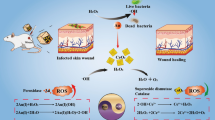Abstract
Oxidative stress in the lung epithelial A549 cells and macrophages J774A.1 due to contact with commercially important nanomaterials [i.e., nano-silver (nAg), nano-alumina (nAl2O3), single-wall carbon nanotubes (CNT), and nano-titanium oxide anatase (nTiO2)] was evaluated. Nanomaterial-induced intracellular oxidative stress was analyzed by both H2DCFDA fluorescein probe and GSH depletion, extracellular oxidative stress was assessed by H2HFF fluorescein probes, and the secretion of chemokine IL-8 by A549 cells due to elevation of cellular oxidative stress was also monitored, in order to provide a comprehensive in vitro study on nanomaterial-induced oxidative stress in lung. In addition, results from this study were also compared with an acellular “ferric reducing ability of serum” (FRAS) assay and a prokaryotic cell-based assay in evaluating oxidative damage caused by the same set of nanomaterials, for comparison purposes. In general, it was found that nanomaterial-induced oxidative stress is highly cell-type dependent. In A549 lung epithelial cells, nAg appeared to induce highest level of oxidative stress and cell death followed by CNT, nTiO2, and nAl2O3. Different biological oxidative damage (BOD) assays’ (i.e., H2DCFA, GSH, and IL-8 release) results generally agreed with each other, and the same trends of nanomaterial-induced BOD were also observed in acellular FRAS and prokaryotic E. coli K12-based assay. In macrophage J774A.1 cells, nAl2O3 and nTiO2 appeared to induce highest levels of oxidative stress. These results suggest that epithelial and macrophage cell models may provide complimentary information when conducting cell-based assays to evaluate nanomaterial-induced oxidative damage in lung.






Similar content being viewed by others
References
Arrick BA, Nathan CF (1984) Glutathione metabolism as a determinant of therapeutic efficacy: a review. Cancer Res 44(10):4224–4232
Baggiolini M, Walz A, Kunkel SL (1989) Neutrophil-activating peptide-1/interleukin 8, a novel cytokine that activates neutrophils. J Clin Invest 84(4):1045–1049
Bello D, Hsieh S-F, Schmidt D, Rogers E (2009) Nanomaterials properties vs. biological oxidative damage: implications for toxicity screening and exposure assessment. Nanotoxicology 3(3):249–261
Cohen J, DeLoid G, Pyrgiotakis G, Demokritou P (2012) Interactions of engineered nanomaterials in physiological media and implications for in vitro dosimetry. Nanotoxicology 7(4):417–431
Gou N, Onnis-Hayden A, Gu AZ (2010) Mechanistic toxicity assessment of nanomaterials by whole-cell-array stress genes expression analysis. Environ Sci Technol 44(15):5964–5970
Hardman R (2006) A toxicologic review of quantum dots: toxicity depends on physicochemical and environmental factors. Environ Health Perspect 114(2):165–172
Hsieh S-F, Bello D, Schmidt DF, Pal AK, Rogers EJ (2012) Biological oxidative damage by carbon nanotubes: fingerprint or footprint? Nanotoxicology 6(1):61–76
Koike E, Kobayashi T (2006) Chemical and biological oxidative effects of carbon black nanoparticles. Chemosphere 65(6):946–951
Lakshminarayanan V, Beno DWA, Costa RH, Roebuck KA (1997) Differential regulation of interleukin-8 and intercellular adhesion molecule-1 by H2O2 and tumor necrosis factor-α in endothelial and epithelial cells. J Biol Chem 272(52):32910–32918
Mariano M, Spector WG (1974) The formation and properties of macrophage polykaryons (inflammatory giant cells). J Pathol 113(1):1–19
Meister A, Anderson ME (1983) Glutathione. Annu Rev Biochem 52(1):711–760
Nel A, Xia T, Madler L, Li N (2006) Toxic potential of materials at the nanolevel. Science 311(5761):622–627
Rahman I, Kode A, Biswas SK (2007) Assay for quantitative determination of glutathione and glutathione disulfide levels using enzymatic recycling method. Nat Protoc 1(6):3159–3165
Rushton EK, Jiang J, Leonard SS, Eberly S, Castranova V, Biswas P, Elder A, Han X, Gelein R, Finkelstein J, Oberdörster G (2010) Concept of assessing nanoparticle hazards considering nanoparticle dosemetric and chemical/biological response metrics. J Toxic Environ Health 73(5–6):445–461
Sies H (1999) Glutathione and its role in cellular functions. Free Radic Biol Med 27(9–10):916–921
Vlahopoulos S, Boldogh I, Casola A, Brasier AR (1999) Nuclear factor-κB-dependent introduction of interleukin-8 gene epression by tumor necrosis factor: evidence for an antioxidant sensitive activating pathway distinct from nuclear translocation. Blood 94(6):1878–1889
Wang G, Zhang J, Dewilde AH, Pal AK, Bello D, Therrien JM, Braunhut SJ, Marx KA (2012) Understanding and correcting for carbon nanotube interferences with a commercial LDH cytotoxicity assay. Toxicology 299(2–3):99–111
Xia T, Li N, Nel AE (2009) Potential health impact of nanoparticles. Annu Rev Public Health 30:137–150
Acknowledgments
The study was funded through the National Science Foundation as a Nanoscale Science and Engineering Centers Program (Award # NSF-0425826) and EEC-0425826 (Supplement). Some experiments were conducted at the George J. Kostas Nanoscale Technology and Manufacturing Research Center at Northeastern University.
Conflict of interest
None.
Author information
Authors and Affiliations
Corresponding author
Rights and permissions
About this article
Cite this article
Wang, L., Pal, A.K., Isaacs, J.A. et al. Nanomaterial induction of oxidative stress in lung epithelial cells and macrophages. J Nanopart Res 16, 2591 (2014). https://doi.org/10.1007/s11051-014-2591-z
Received:
Accepted:
Published:
DOI: https://doi.org/10.1007/s11051-014-2591-z




